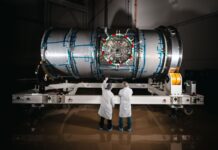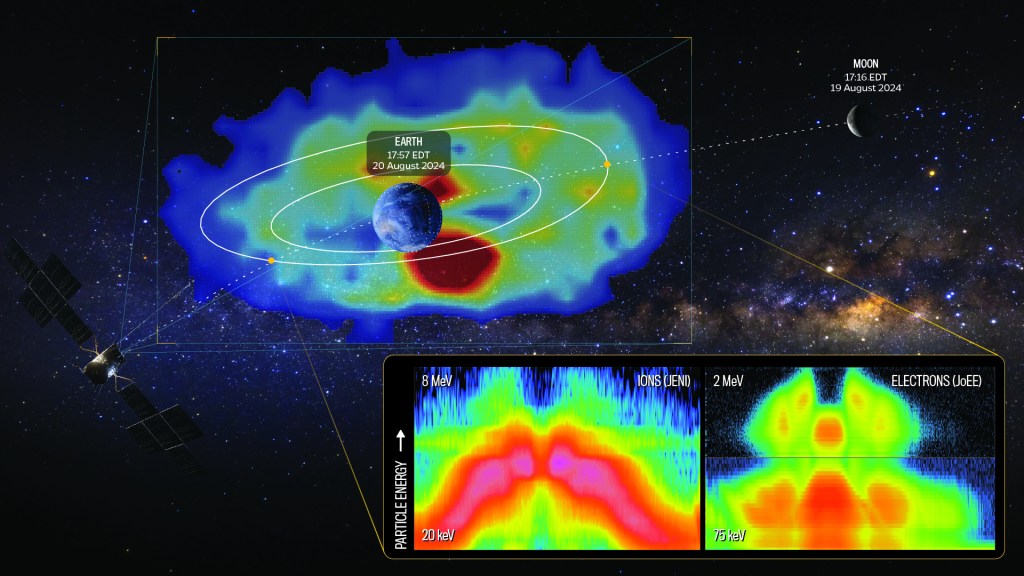Juice Spacecraft Ventures Into Earth’s Magnetosphere
On August 20, the European Space Agency’s (ESA) Jupiter Icy Moons Explorer (Juice) spacecraft made a significant leap in its journey towards Jupiter. It entered Earth’s magnetosphere, soaring approximately 37,000 miles (60,000 kilometers) above the Pacific Ocean. This marked a crucial milestone, as Juice’s instruments experienced the intense space environment that awaits them at Jupiter.
Understanding Earth’s Magnetosphere
The magnetosphere is a region of space dominated by Earth’s magnetic field. It acts as a shield, protecting our planet from the solar wind—a stream of charged particles emanating from the sun. As Juice traversed this area, its instruments got their first exposure to the conditions they will encounter near Jupiter. The spacecraft’s journey took it through the magnetotail, a part of the magnetosphere that trails behind Earth like a comet’s tail, filled with dense, lower-energy plasma.
Instruments on Board: JoEE and JENI
Juice is equipped with several advanced instruments, two of which are particularly noteworthy: JoEE (Jovian Energetic Electrons) and JENI (Jovian Energetic Neutrals and Ions). These instruments are designed to study the plasma—the hot, ionized gas that fills space—around Jupiter. During its passage through the magnetotail, JoEE and JENI encountered dense, lower-energy plasma. This initial interaction provided valuable data that will help scientists understand the environment Juice will face at Jupiter.
Into the Heart of Radiation Belts
After navigating the magnetotail, Juice plunged into Earth’s radiation belts. These belts are zones of charged particles trapped by Earth’s magnetic field and are known for their high radiation levels. The spacecraft’s instruments measured the plasma, which can reach temperatures of millions of degrees. This data is crucial for investigating how plasma heating occurs, a process that fuels dramatic phenomena in planetary magnetospheres.
Significance of Plasma Heating
Plasma heating is a key area of study in space science. It helps explain various phenomena such as auroras, which are stunning displays of light caused by interactions between solar wind and a planet’s magnetic field. By studying the plasma around Earth, scientists can draw parallels to similar processes occurring near Jupiter. This knowledge will enhance our understanding of the giant planet’s magnetosphere and its interactions with its moons.
Juice’s Mission to Jupiter
Juice’s primary mission is to explore Jupiter and its three largest moons: Ganymede, Callisto, and Europa. These moons are believed to harbor subsurface oceans, making them prime candidates in the search for extraterrestrial life. The spacecraft will study their surfaces, subsurfaces, and atmospheres, providing unprecedented insights into these fascinating celestial bodies.
The Journey Ahead
The journey to Jupiter is long and arduous. Juice will travel for several years before reaching its destination. Along the way, it will perform multiple gravity-assist maneuvers, using the gravitational pull of Earth and Venus to gain speed and adjust its trajectory. These maneuvers are akin to cosmic slingshots, propelling the spacecraft towards its ultimate goal.
Good to Know: Why Jupiter?
Jupiter is the largest planet in our solar system, a gas giant with a mass more than 300 times that of Earth. Its immense gravitational field has a significant influence on the solar system, affecting the orbits of other planets and capturing numerous asteroids and comets. Studying Jupiter and its moons can provide insights into the formation and evolution of our solar system.
Historical Context
The exploration of Jupiter has a rich history. Pioneer 10 was the first spacecraft to visit Jupiter in 1973, followed by several missions including the famous Voyager probes, Galileo orbiter, and more recently, Juno. Each mission has unveiled new aspects of the giant planet, making it one of the most studied celestial bodies in our solar system.
Reactions from the Scientific Community
The scientific community is abuzz with excitement over Juice’s mission. Researchers are eager to analyze the data collected during its passage through Earth’s magnetosphere. This information is expected to pave the way for groundbreaking discoveries once Juice reaches Jupiter.
Conclusion
The Juice spacecraft’s venture into Earth’s magnetosphere marks a significant step in its long journey to Jupiter. By studying the plasma and radiation belts around Earth, Juice is setting the stage for its primary mission: to explore Jupiter and its icy moons. This mission holds the promise of unlocking new secrets about our solar system and potentially finding clues to the existence of life beyond Earth.
For more details, you can refer to the official ESA website.
For more Information, Refer to this article.

































